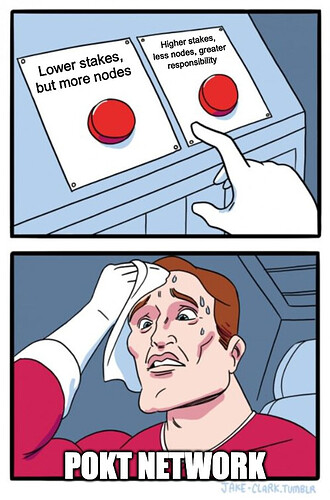Hey POKT Network folks,
I’ve been batting around an idea in a few other threads, and it’s generated some interesting discussions. I think it’s time to give it a thread of its own, so here we go.
We’ve seen how the cost of becoming a node runner has fallen dramatically. Initially, the staking requirement was above $15k; now, it’s under $500 in tokens. This change, combined with Lean Pocket’s fantastic work on slashing hardware costs, has been great for accessibility.
But it seems we might be paying a hidden price. With the average stake per node hovering around $1400 I worry we’re undervaluing our network and diluting our token value.
So, I propose we slowly roll back the tide and gradually reintroduce higher stakes, kind of like the good old days, but in a steady, manageable way. We might pull this off using a “ServicerStakeWeightMultiplier”-like system that rewards keeping stakes above a certain threshold. To avoid causing a price surge, we’d need to move cautiously, increasing stakes in small steps to accommodate limited market liquidity.
Here’s a paradox: Higher stake requirements might initially reduce ROI, leading to some runners opting out. But a reduction in competition means better rewards for those who stay and might actually attract others to join.
Furthermore, this gradual increase could push “overstaked” LeanPockets to consolidate. For example, someone running 20 nodes with an average $1k stake would face a $10k additional investment per $500 increase, or a total of $180k to reach a $10k stake requirement. This could promote decentralization and further reduce node count.
Although it may seem counterintuitive, I firmly believe that decreasing the node count is crucial, especially during times of falling prices. After all, most, if not all, node runners need to cover their bills in USD. With an average operational cost of about $50 per node, POKT network is currently shouldering a hefty $1M per month while at the same time value of the stake is going down the hill.
Final thoughts - with higher stake there comes greater responsibility. That currently does not seem to be a case. For instance, becoming a validator costs roughly $2k at current price. That means (does it?!) you can overtake first 1000 validators just by staking a little above $2-3M in total, which is less than 10 % of currently staked POKT.
I’m no expert on this, so do take my thoughts with a pinch of salt. I wanted to spark a discussion without crowding other threads. All feedback is appreciated!
